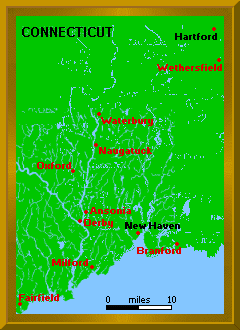 |
ELIZABETH ROOKE, REOSA, ROOSA, ROOSE or ROSE?
Savage does not include any ROOKE, REOSA, ROOSA or ROOSE in his Dictionary of the First Settlers[S5], although this is negative proof rather than positive proof. The Ulster County Historical Society (of New York) has published a history of The Roosa Family of North America[S14]. This does not mention any Elizabeth Roosa of Roxbury, or any Roosa family in that time or place. The book does list an Elizabeth Roosa born in 1617 in Canterbury, England as the daughter of Heyman Guysbert Roosa, but Heyman and his family did not come to New Amsterdam until 1660[S14].
However, both Savage[S5] and Coldham's Complete Book of Emigrants[S13] quote the following as landing in New England on 30APR1634: "Passengers from Ipswich by the Francis of Ipswich, Mr John Cutting, bound for New England: Robert Rose 40 and Margery his wife 40, John Rose 15, Robert Rose 15, Elizabeth Rose 13, Mary Rose 11, Samuell Rose 9, Sarah Rose 7, Danyell Rose 3, Darcas Rose 2".[S19].
THE ROSE FAMILY
Adams & Styles [S67] describe Robert Rose as:
"Robert Rose, who left Ipswich, England in April 1634, probably coming directly to Wethersfield, CT. He was a fellow passenger with several Watertown families, and it is not clearly ascertained, says Bond, 'that this family settled in Watertown.'(MA) His sons Robert and John were with him. He was one of the largest original holders of 'adventurers lands.' His homestead was on the east side of Broad Street, between Lieut.Seeley's and John Clarke's. He became one of the first settlers of Totoket (Branford) in 1644. His son Robert remained in Wethersfield, where...his descendants have been numerous." Fuller details on Robert's residence in Wethersfield, and his serving in the Pequot War, are given in the separate Note on the Wethersfield plantation which follows below. This also refers to the fact that in the list of original planters at Milford, CT, Atwater [S66] identifies Edward as coming from Wethersfield as well.
Elizabeth's father Robert left her 20 pounds in his will but, unfortunately, did not refer to her by her married surname.[S32]. The will was made in Branford dated 25AUG1664. It is said that Elizabeth possibly died 02SEP1634 at Branford though this has not been corroborated [S69]. Admittedly, Edward of Roxbury's will dated 02SEP1670 makes a bequest to "my daughter-in-law my son Edward Riggs his wife" without mentioning her christian name, but no evidence has yet been found to prove Edward's first wife died and that he re-married.
Nevertheless, corroborating evidence that Edward married Elizabeth ROSE is provided by the will of Lt.Samuel Rose, Elizabeth's brother. In it, he left a cash bequest to his "cousin" Phebee Day (relationships were described far more loosely in those days, and cousin often referred to a more remote relative). Edward and Elizabeth's daughter Mary, who married a George Day, had a son Paul Day; he in turn had married a Phebee Brown,[S32] thus making Phebee Day Samuel's great-niece. When Samuel Rose made his will, he was living in Newark, NJ [S32], the settlement that Edward had helped to establish.
CONCLUSION
Having been described as 13 on 30APR1634 when she landed in New England, Elizabeth ROSE would have been about 14 or 15 at the time of the marriage on 05APR1635, but Wallace[S3] describes her as "quite a young girl"). Edward, having been baptised on 17OCT1619[S1][S2], would have been 15 and a half. I assume the early settlers in the Massachussets Bay Colony observed the same law as in England at that time, in that the youngest age for marriage was 14 for boys and 12 for girls).
In all probability, based on the above facts, the marriage on 05APR1635 at Roxbury was therefore of Edward of Roxbury's son Edward, not Edward of Roxbury himself, and was to Elizabeth ROSE. Edward and Elizabeth named one of their sons Samuel, probably after her younger brother who settled near them in Newark NJ (one of Elizabeth Holmes's brothers - Edward's uncle - was also named Samuel, but there is no evidence that he followed them to New England, or was as close as Elizabeth and her brother Samuel seemed to have been).
|
 |







 At the time Milford contained the area northwest of the actual town proper first called the Plantation of Paugassett, which later became the separate Township of Derby.
At the time Milford contained the area northwest of the actual town proper first called the Plantation of Paugassett, which later became the separate Township of Derby. New Haven Colony consisted of the townships of New Haven itself, Branford, Guilford, Milford and Stamford, as well as Southampton, Long Island (Derby was considered part of Milford until 1675). It practised the Puritan beliefs far more strictly than the separate Connecticut Colony, insisting that only members of Puritan churches had the right to vote or reside in its towns
New Haven Colony consisted of the townships of New Haven itself, Branford, Guilford, Milford and Stamford, as well as Southampton, Long Island (Derby was considered part of Milford until 1675). It practised the Puritan beliefs far more strictly than the separate Connecticut Colony, insisting that only members of Puritan churches had the right to vote or reside in its towns